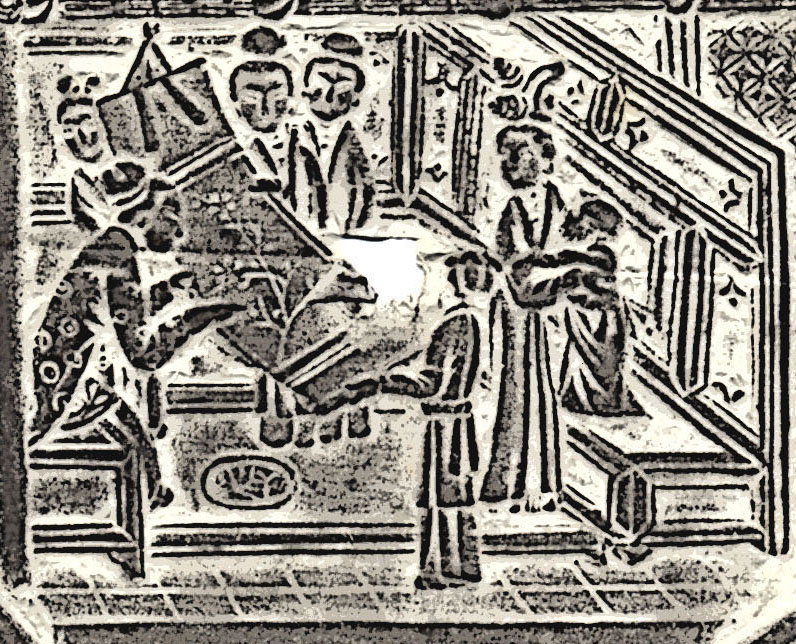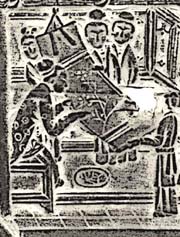The Picture
CASE 1: Women and Arts in the 13th Century
WHAT IS DEPICTED IN THIS PICTURE?
The picture says it all: five women, a young girl, and a toddler are gathered together inside a room looking at a painting of a plum branch. The architecture indicates that this is a fairly wealthy household, though the women’s clothing is not as opulent as those depicted in contemporaneous pictures of noble ladies. To our right, one woman tends to a toddler standing on a couch; to our left, another woman sits and gestures as if lecturing about her painting and what it means. These two women mark off a spectrum of possibilities, which is the real subject of the mirror and the inscription: some women simply bear and raise children, whereas some also create works of intellect and art.
WHERE SHOULD YOU BEGIN WHEN LOOKING AT A CHINESE PAINTING?
The Right Side of the PictureThe artist would know that a Chinese viewer would start on the right side of the picture and read toward the left, also moving generally from front to back; therefore, the first thing he shows us is the woman tending the child, who stands on a couch. She leans toward the toddler gently and he turns, holding her tightly (look at the folds on his lower gown—you can see that his body is turned toward her). These two figures exemplify a traditional womanly ideal: a gentle woman looking after a loving child.
|
||
The Left Side of the PictureAll the women to the left of this scene are busy appreciating the painting. First, we see a young girl, perhaps a maid, who holds the end of the painting for the artist. By helping her mistress practice her art, this young girl will learn how to handle a painting or talk about it intelligently. Behind the painting, we see three women looking at it, one of whom holds up its top end with a special type of rod made for the purpose. She too, may be a maid. Notice that the artist is the only one who sits, pointing out interesting details and teaching the other women various aspects of painting and its appreciation.
|
||
THE PAINTING IN THE PICTURE
The painting in the picture reveals a great deal about the woman who (in the fictional world of the picture) painted it. The painting is not mounted on a screen with heavy, carved wooden borders or onto furniture, as was the older custom, which would be expensive and difficult to transport. No, this woman chose to paint in the “hanging scroll” format. As you can see, paintings in this format could bend. This is because they were mounted on several layers of paper, usually with a cover made of woven silk. A wooden roller at the bottom served as a support when the painting was rolled up. Notice how carefully the girl in the picture holds the roller so as not to soil the paper with her hands. Of course, a hanging scroll would seem much less imposing than a painting mounted in a fancy wooden frame, but that was part of the appeal. You see, for the more educated collectors of this period, the ones we call “literati” collectors in English, a painting’s charm lay not in its obvious beauty but in the thought, sensitivity, and intelligence that went into it. A lavishly carved frame would only distract the connoisseur who wanted to peer into the artist’s mind.
THE ART MARKET
There was yet another advantage to the hanging scroll format: it was easy to buy and sell. By this time the art market in China was quite lively, so paintings were increasingly mounted in portable formats that could be easily transported, traded, or sold. Writings from the period speak of shops and restaurants with paintings displayed for sale. We also read about savvy dealers or crafty forgers, all of whom made handsome profits because of the incredible desire for great works of art. When someone in China looked at this mirror, he or she would know that the woman depicted was probably familiar with the latest trends in art appreciation.
PLUM FLOWERS
The main subject of the picture in the mirror is plum flowers, and the subject of the picture in the mirror is a woman who paints pictures of plum flowers, but that picture and her painting within that picture are both enclosed in a mirror shaped like a flower!
To understand what is so special about plum flowers, you need to know two things:
1. Poets had long been fond of comparing beautiful women with plum blossoms, but they had a particular type of women in mind. The plum blossom, although beautiful, is able to withstand the cruelty and harshness of cold weather and does not try to impress with showy petals, as one finds in the less rugged peony, for instance. For this reason, plum blossoms often were associated with women who had a strength of character, whereas peonies were compared more often to sensuous, if pampered, palace beauties.
2. A famous story relates the tale of a princess who liked to lie beneath the eaves of the palace buildings. One day a plum blossom landed in the middle of her forehead. She liked the look and kept it there. Later it became fashionable to use cosmetics to imitate the look of a plum flower on the forehead. This fashion was called “plum makeup.” So, when a woman looked into this mirror, its flower petal contours would automatically frame her reflected face, which suggests a comparison with a plum flower—a nice touch. But if she turned the mirror around, it would suggest that, for this woman, beauty lies deeper and beyond only a pretty face. To follow this line of thought you need to look more closely at the inscription on the mirror.




